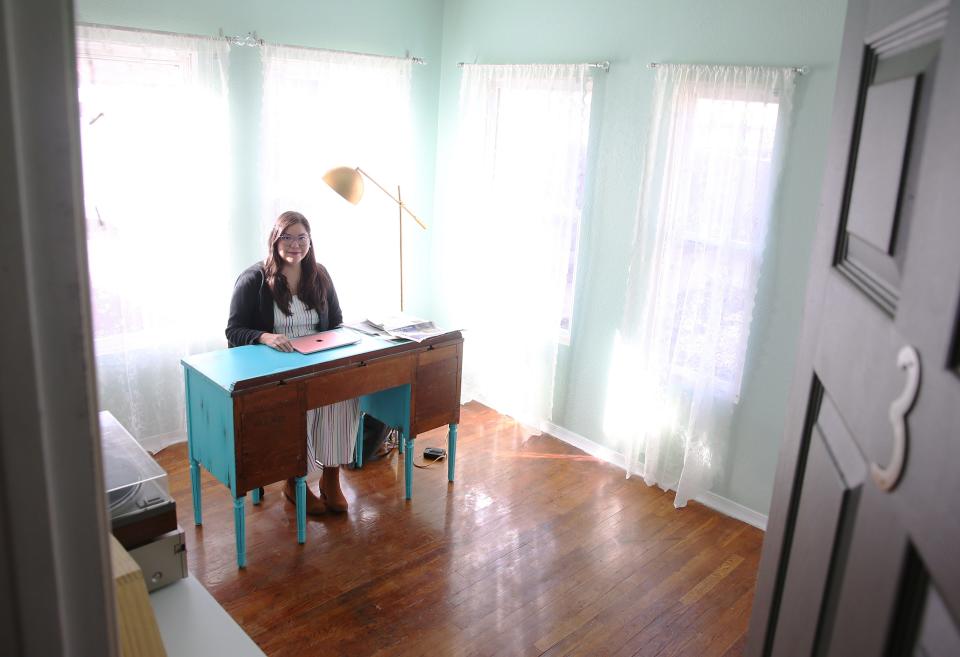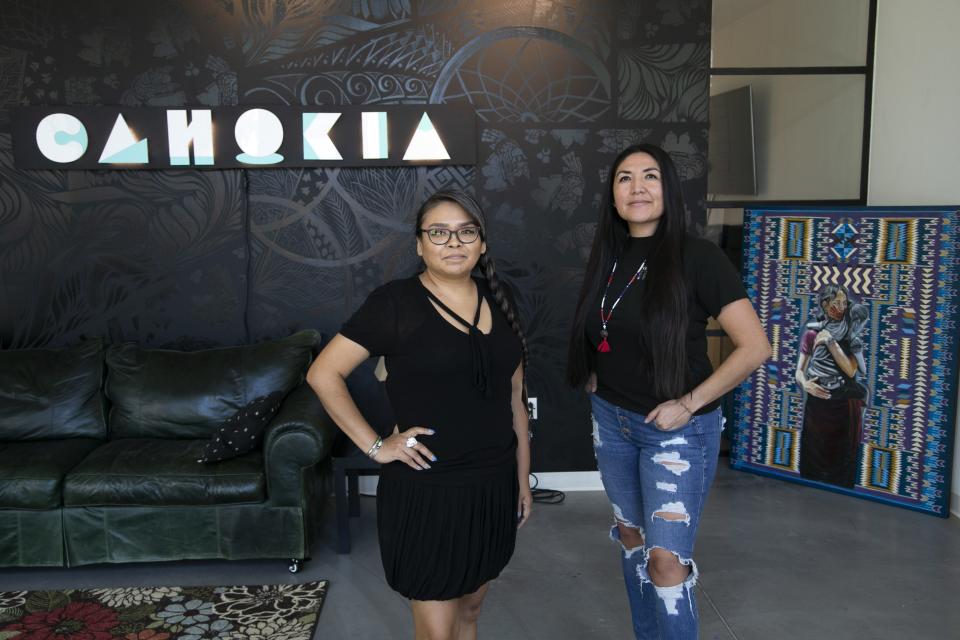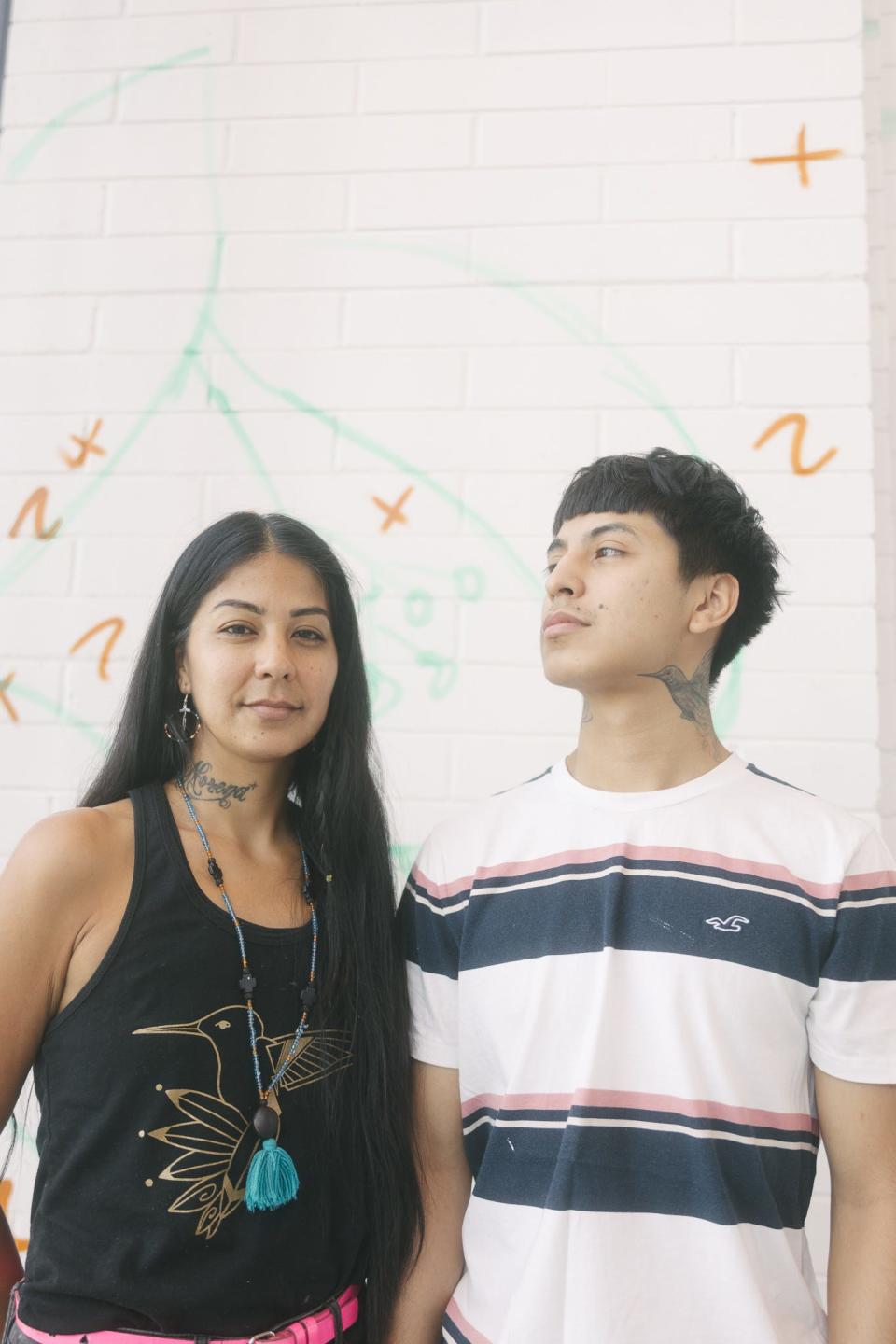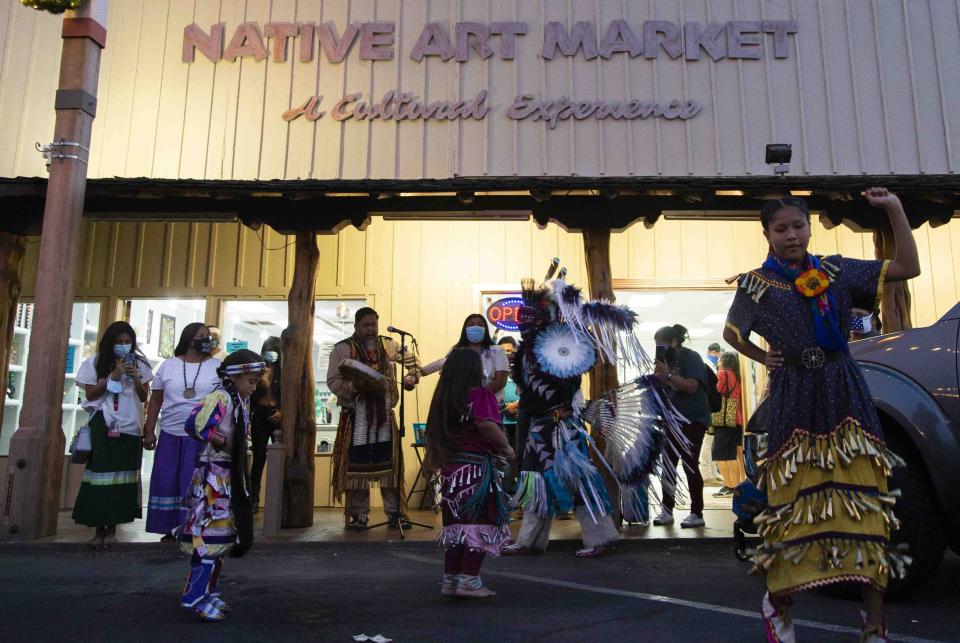22 Instagram accounts in Arizona to follow in honor of Native American Heritage Month
- Oops!Something went wrong.Please try again later.
- Oops!Something went wrong.Please try again later.
In honor of Native American Heritage Month in the U.S., we are highlighting Instagram accounts of Indigenous artists, organizations, business owners and social media influencers in Arizona who use their platforms to support Native creatives, entrepreneurs, causes, cultures and traditions.
Instagram accounts that you should check out include a world-renowned hoop dancer, a Phoenix-based collective that hosts what it describes as "Indigenous-led programming" and a Diné woman-owned press that publishes Native writers and poets.
Across Arizona, there are 22 federally recognized tribes, including the Ak-Chin Indian Community, Fort McDowell Yavapai Nation, Gila River Indian Community and Salt River Pima-Maricopa Indian Community in the Phoenix area.
In Whiteriver, on the Fort Apache Indian Reservation in eastern Arizona, Douglas Miles Jr. is the force behind an effort to create a skatepark that pro skateboarder Tony Hawk's foundation, the Skatepark Project, has pledged to invest in to create a world-class skating destination.
Here are 22 Instagram accounts and influencers in central Arizona that you should get to know.
Check out our previous lists: National Hispanic Heritage Month,Asian Pacific American Heritage Month, Pride Month, African American History Month.
A 'long overdue' change:Grand Canyon changes "offensive" campground name

Abalone Mountain Press, aka @abalonemountainpress
Abalone Mountain Press, started by poet and writer Amber McCrary (@abaloneamber87), is a Diné woman-owned press dedicated to creating “a space for Indigenous voices to be heard.” She told Poetry Magazine in September 2022 that "Many Native writers I’ve worked with or read have a drive and a passion for having their stories told in a non-western way, or a way that strays from the white gaze. This is what I hope to continue."
The name refers to Abalone Shell Mountain (Dookʼoʼoosłííd), also known as the San Francisco Peaks — a mountain that is sacred to several tribes — near Flagstaff, where McCrary grew up.
“I was just having the hardest time trying to find something for me as an Indigenous feminist (and) Indigenous poetic,” McCrary previously told The Arizona Republic in 2021. “It was really hard to find a home like that.”
Abalone Mountain Press publishes books, chapbooks and zines by Indigenous people, McCrary told Poetry Magazine.
Where to find them: https://www.instagram.com/abalonemountainpress, https://www.abalonemountainpress.com.
For subscribers: Get to know Abalone Mountain Press and its Nurture House neighbors
Thomas “Breeze” Marcus, aka @breeze1phx
Thomas Marcus, also known as Breeze, is an artist who is inspired by and honors his Tohono O'odham and Akimel O’odham heritage — including the designs of their basketry — in many of his works. His murals are “about reclamation of space, land and representation,” he wrote in a Instagram post.
“Murals that are my favorite are the ones that I can actually express different stories and old narratives from my culture and do it in a contemporary manner,” Marcus told The Republic in 2021. “It's that representation of our Native stories, which are completely overlooked.”
Where to find them: https://www.instagram.com/breeze1phx.
Exclusive: How Breeze shares his culture's stories one exquisite detail at a time

Cahokia, aka @cahokiaphx
Cahokia SocialTech + ArtSpace in downtown Phoenix is an Indigenous-led and women-owned collective “that seeks to uplift Indigenous design, art and culture through pop-up events and retail,” according to its website.
Co-founders Eunique Yazzie (Navajo) and Melody Lewis, who is Mojave, Tewa and Hopi, opened the space on Roosevelt Row in 2021.
“We want this place to be in the modern sense where Indigenous people create and innovate and exchange knowledge, tools, resources and ideas,” Yazzie told The Republic prior to the grand opening on Indigenous Peoples Day 2021.
Where to find them: https://www.instagram.com/cahokiaphx, https://www.cahokiaphx.com.
Learn about Cahokia: Art space founded by Indigenous women comes to Phoenix

Douglas Miles, aka @dmiles1_apache
Douglas Miles’ (San Carlos Apache/Akimel O'odham) artwork and influence can be found across the country. His company, Apache Skateboards, got its start in 2002 when he painted an Apache warrior design on his son’s first skateboard, Douglas Miles Jr. told The Republic in 2021.
In his work, which spans various mediums including photography and murals, Miles centers Apache and Native American voices “as the builders and owners of their own narrative,” he told Arizona State University in 2021. In this interview, he revealed that he was influenced by lowrider culture and graffiti art in his formative years in south Phoenix.
Miles shares his latest works and weighs in on contemporary issues on Instagram as @dmiles1_apache.
Where to find them: https://www.instagram.com/dmiles1_apache, https://apacheskateboards.com.
Doug Miles Jr., aka @steezyapache
Professional skateboarder and filmmaker Doug Miles Jr. grew up skateboarding in his hometown of San Carlos on the San Carlos Apache Indian Reservation. In recent years, he's been involved in getting renovation projects for skateparks off the ground on reservations. The San Carlos skatepark opened in April 2022, and a proposal for a new skatepark in Whiteriver, which he has been the driving force behind, has received backing from Tony Hawk's foundation, the Skatepark Project.
“I call myself the rez skateboarding expert,” he told The Republic in 2021. "When kids go here to skate, this isn’t only going to create skaters. This park (in Whiteriver) is going to create filmmakers and it's going to create photographers; it's going to create business owners, it's going to create social media people."
Where to find them: https://www.instagram.com/steezyapache, https://www.instagram.com/indellicax.
We're going to get the skateparkHow an Apache pro skater and Tony Hawk's foundation teamed up
Florinda Wilson, aka @sparklemomm.blog
Florinda Wilson, who calls herself "a strong Diné (woman)" on her website, does digital marketing in the Phoenix area. On Instagram, she promotes local businesses and gets candid about life with a family of six.
Where to find them: https://www.instagram.com/sparklemomm.blog, https://sparklemomm.com.
Hakirí Coffee, aka @hakiricoffee
Catherine Zingg created Hakirí Coffee — which will be renamed Strawberry Coffee — with her sister in 2021. As of fall 2022, the Ho-Chunk-owned bus can be found at Monsoon Market (3508 N. Seventh St.) on weekends. Zingg prioritizes sourcing ingredients for her coffee drinks — which range from lattes to shakeratos — from Native-owned businesses.
Where to find them: https://www.instagram.com/hakiricoffee.
More:Where to buy Native American foods and ingredients in metro Phoenix
The Heard Museum, aka @heardmuseum
As one of Phoenix’s first cultural attractions — opened in 1929 — the Heard Museum is dedicated to “the advancement of American Indian art” by showcasing Native Americans’ first-person perspectives.
For all of the Heard’s upcoming events, including First Friday celebrations, go to https://heard.org/events.
Where to find them: https://www.instagram.com/heardmuseum, https://heard.org.
Phoenix SunsPlayers rock jerseys honoring Native Americans in Arizona
H.E.R. Medicine, aka @h.e.r.medicine
Artists Deonoveigh (Deon) Mitchell (@kaalogii_kisses) and Mikenzi Dupree (@stillshelives) founded H.E.R. Medicine, which stands for “heal, empower, rise," at 2939 N. 67th Place in Scottsdale.
According to their Instagram page, they are “Indigenous sisters aspiring to inspire & empower others at every stage of their healing journey through art.” Their artworks are sold at the store, and the duo often hosts events such as artisan marketplaces where local vendors sell their handcrafted goods.
Where to find them: https://www.instagram.com/h.e.r.medicine, https://www.instagram.com/kaalogii_kisses, https://www.instagram.com/stillshelives.
Imagine Threads, aka @imaginethreadco
Imagine Threads, which designs "streetwear for Arizona," according to its Instagram bio, was founded by Cesar Rodriguez, who grew up in Guadalupe. Rodriguez — who is of Yaqui/Chicano descent, according to Imagine Threads' bio — shares his latest designs and fashion events that he showcases at on Instagram.
Imagine Threads can be found inside Open Mind Emporium at Arizona Mills in Tempe.
Where to find them: https://www.instagram.com/imaginethreadco, https://imaginethreadsco.bigcartel.com.
Indigenous Community Collaborative, aka @indigenous.cc
According to its website, the Indigenous Community Collaborative is a Native American, women-owned social enterprise based in Phoenix that aims to amplify “Indigenous truth, values, resiliency and validation.” They do this through partnering with tribal communities and organizations to provide support and programming.
On their Instagram page, IndigenousCC shares upcoming events and quotes from inspirational figures for #MatriarchMotivationMonday.
Where to find them: https://www.instagram.com/indigenous.cc, https://www.indigenouscc.org.
Jesse Yazzie, aka @jesse.yazzie
Jesse Yazzie's murals can be found across the state. Yazzie, who is Navajo and grew up in Phoenix, has been artistically inclined from a young age, but his experiences with incarceration and addiction had a strong influence on his artwork as an adult.
"It's not the mistake that defines the person. It's how they react to what they've done,” Yazzie told The Republic in 2021.
As explained on his website, his works "are inspired by traditional Native American teachings infused with the aesthetic of the Chicano neighborhoods of North Phoenix. Yazzie often uses Navajo motifs to showcase his ancestral roots, and his use of the Native geometric rug designs alongside the Arizona flag colors and cityscapes are telling of his experience growing up in both Phoenix and the Navajo Reservation."
Where to find them: https://www.instagram.com/jesse.yazzie, https://www.jesseyazzie.com.

La Morena, aka @lamorena_art
Lucinda Hinojos, also known as La Morena, is a painter and muralist from Glendale. Some of her most well-known murals include one in south Phoenix of a young migrant field worker releasing doves and butterflies from their cage and another dedicated to missing and murdered Indigenous women and girls.
Hinojos, who is of Xicana, Apache and Yaqui descent, reflects on “immigration, community, feminism and spirituality” through her artwork, according to her website.
“I feel many of my relatives gravitate toward my work because they see themselves in it; they feel as if they are being seen and heard,” she told The Republic in 2021. “However, our representation is needed and the work we do is essential. There have been too many times where we have white representation telling our stories.”
Where to find them: https://www.instagram.com/lamorena_art, https://lamorenaart.com.
Resilience through art: Yaqui artists build community by honoring their ancestors
Local Matriarch, aka @localmatriarch
Local Matriarch — a "platform for storytelling and community building," as described on Cahokia's website — was founded by Diné entrepreneur Tashena López and her wife Claudia López, an Indigenous artist from Mexico. The duo aims to "help Indigenous womxn in rural areas materialize legacy and preserve culture" and uses Instagram to share markets, lectures and other events that Local Matriarch organizes and participates in.
Where to find them: https://www.instagram.com/localmatriarch.
Rocio Francis, aka @morningmistsoapco
Rocio Francis, who uses she and her as well as they and them pronouns, has a philosophy of respecting the Earth as she creates small-batch products made from ingredients that are responsibly sourced from local businesses or even her own backyard.
Francis, who is Diné, Laguna Pueblo, Acoma Pueblo and Apache and was born and raised in Phoenix, hopes to inspire others to live a sustainable lifestyle with Morning Mist Soap Co.’s plastic-free and vegan products, which include soaps, serums, deodorants and lotions that use biodegradable packaging.
On Instagram, Francis shares photos of her products and has previously shared her experiences with schizencephaly, which causes epilepsy.
Where to find them: https://www.instagram.com/morningmistsoapco, https://www.morningmistsoapco.com.

Native Art Market, aka @nativeartmarket
In November 2018, Denise Rosales and her daughters Heather Tracy and Devin Shea Tunney started a weekly open-air market that operates from November through March with 10 vendors. When they opened for the 2019 winter season, Native Art Market boasted 30 to 40 vendors and Native performers each week at the Pavilions at Talking Stick on the Salt River-Pima Maricopa Indian Community.
In 2020, with help from their community, the family was able to open their first indoor marketplace where more than 300 Native artisans’ products are sold with the aim to economically empower Native American artists by allowing them to sell directly to consumers through the store, which offers affordable shelf space.
“We want to benefit the Native community directly; they can tell their own stories,” Tracy told The Republic.
On Instagram, Native Art Market shares details for upcoming events.
Where to find them: https://www.instagram.com/nativeartmarket, https://www.thenativeartmarket.com.
'A longtime dream': How a Navajo family opened their first store in Scottsdale
Native Coffee Co., aka @nativecoffeeco.az
Raul and Brittany Chavez of Goodyear are “living the dream” with Native Coffee Co., a trailer parked at 9256 W. Van Buren St., Tolleson (check their Instagram to see where they are parked on a given day). They sell coffees and teas with the intention of highlighting their O'odham and Chicano cultures, according to their website.
Their espresso beans are sourced from Chiapas, Mexico, and roasted by Quetzal Co-Op, a nonprofit in Phoenix that supports Indigenous communities by purchasing coffee beans from family farms in Mexico and Guatemala. Their teas are sourced from the Tucson nonprofit Native Seeds/SEARCH that promotes sustainable farming and crop diversity in the Southwest.
Where to find them: https://www.instagram.com/nativecoffeeco.az, https://nativecoffeecompany.square.site.
More: Celebrate Native food culture at these 7 Indigenous-owned restaurants
Caitlin O'Reilly, aka @nizhonifulme
Fashion enthusiast Caitlin O’Reilly shares thrift shopping tips, eco-conscious lifestyle advice and her local adventures as Nizhóníful Me — a name inspired by Nizhóní, the Navajo word for “beautiful.”
O’Reilly says she embraces her culture through her style and everyday life and usually shares content about her travels and outfits.
Where to find them: https://www.instagram.com/nizhonifulme, https://www.youtube.com/c/NizhonifulMe.

OXDX, aka @oxdxclothing
OXDX, a Diné- and Chicana-owned clothing label, “offers unique content and designs to properly represent Native people,” according to its website. Founder Jared Kee Yazzie, a self-taught graphic designer and print maker, and partner Allie Stone are the creatives behind the Tempe-based label, at 1425 E. University Dr., Suite B-104.
The name, OXDX, is an acronym for “overdose” and encourages people to “check your consumption, question your contribution to land and water and to think back on ancestral teachings,” according to their website. OXDX’s Instagram shares its latest designs and events where customers can connect with the brand.
Where to find them: https://www.instagram.com/oxdxclothing, https://www.oxdxclothing.com.
For subscribers: These Native fashion designers tell their stories through clothing
Pueblo Grande Museum and Archaeological Park, aka @pueblograndemuseum
Pueblo Grande Museum and Archaeological Park preserves the remains of what was once one of the Hohokam people’s largest villages.
Some O'odham peoples today prefer the name Huhugam. The Huhugam built canals by hand to supply their communities with water in the Sonoran Desert; the Pueblo Grande Ruin and Irrigation Sites are the only National Historic Landmark in Phoenix.
The museum shares information about upcoming programming, such as panels, lectures and cultural events.
Where to find them: https://www.instagram.com/pueblograndemuseum, https://pueblogrande.org.
Alana Yazzie, @thefancynavajo
Diné lifestyle and food blogger Alana Yazzie loves to cook, and she shares her latest kitchen creations on her Instagram, @thefancynavajo.
“I love to incorporate my Native American heritage into my everyday life,” reads her blog, The Fancy Navajo, “from wearing turquoise jewelry that my husband, Turquoise Hogan, makes, to cooking traditional Navajo food.”
She also shares recipes for dishes such as blue corn pumpkin pancakes on her blog.
Where to find them: https://www.instagram.com/thefancynavajo, http://thefancynavajo.com.

Tony Duncan, aka @tonyduncan
Tony Duncan (San Carlos Apache and Mandan, Hidatsa and Arikara Nation), a world-champion hoop dancer and flute player, has performed around the world, including with singer Nelly Furtado. He and his wife Violet Duncan (@violetduncan) — a children's book author, educator and dancer who is Plains Cree and Taino from Kehewin Cree Nation — appeared in Furtado’s 2012 music video for “Big Hoops (The Bigger the Better).”
The Duncan family — Tony and Violet as well as their children, Nitanis, Mia, Manaya and Naiche — is based in metro Phoenix, and they all hoop dance. Tony Duncan’s music — traditional and original Native American flute songs — is published through Canyon Records.
More: How Canyon Records became the top indie label of Native American music
“All of the things that we celebrate and honor can be told through hoop dance,” Duncan told Phoenix New Times in 2018. “We make different designs — like an eagle that carries our prayers to the creator. We make a butterfly, which represents love. We make the clouds, which represent the breath of the creator. We make flowers that represent the medicine people and also trees, which provide oxygen.”
Where to find them: https://www.instagram.com/tonyduncan, https://www.tonyduncanproductions.com.
Know of someone who should be added to this list? Reach the reporter at kimi.robinson@gannett.com. Follow her on Twitter @kimirobin and Instagram @ReporterKiMi.
Support local journalism. Subscribe to azcentral.com today.
This article originally appeared on Arizona Republic: Native American Instagram influencers to follow in Arizona

